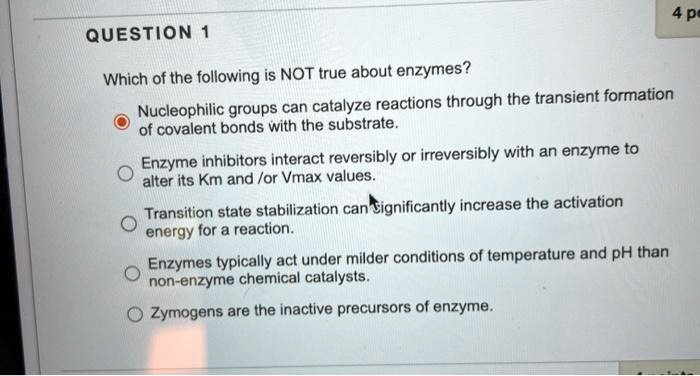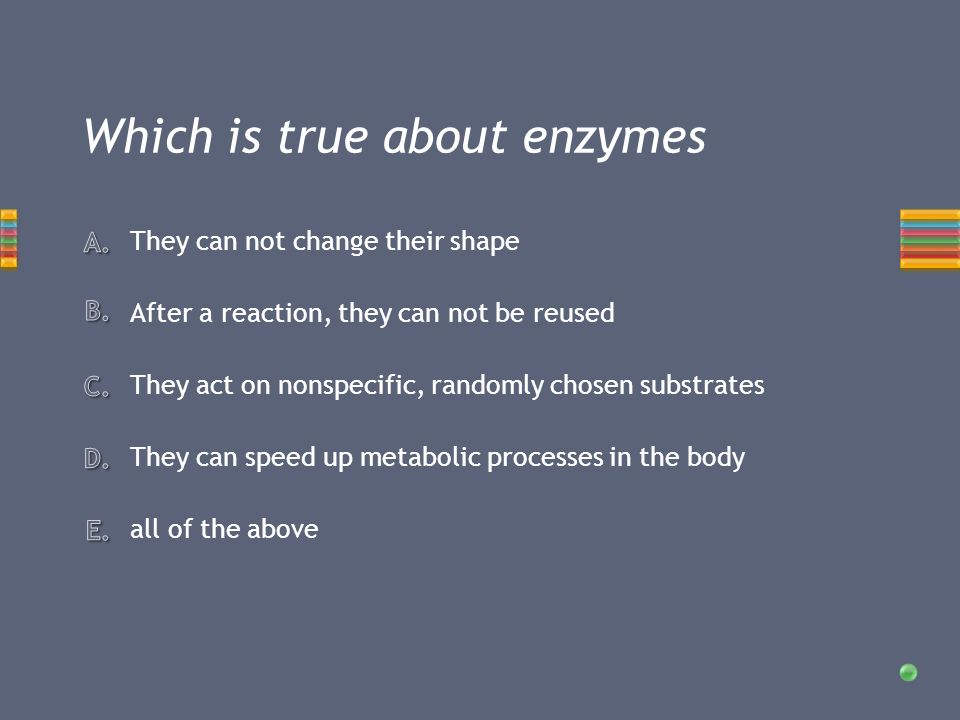Which Is Not True About Enzymes

Imagine a bustling kitchen. Not just any kitchen, but the intricate, microscopic kitchen inside every living cell. Here, tiny chefs, known as enzymes, are tirelessly at work, speeding up reactions that would otherwise take eons. These molecular marvels are essential for life as we know it, but misconceptions about them abound.
This article aims to clarify the common misunderstandings surrounding enzymes by highlighting statements that are frequently mistaken as facts. We'll delve into the true nature of these biological catalysts, separating popular myths from scientific reality. Understanding what enzymes *aren't* is just as crucial as knowing what they *are*.
The Enzyme Enigma: Separating Fact from Fiction
Enzymes are the unsung heroes of biochemistry. They are proteins that act as catalysts, significantly accelerating the rate of chemical reactions within cells. Without them, processes like digestion, muscle contraction, and nerve function would grind to a halt.
However, the complexity of enzyme action often leads to inaccurate assumptions. Let's debunk some of the most prevalent misconceptions.
Myth 1: Enzymes are Consumed in Reactions
One of the most common misconceptions is that enzymes are used up or altered permanently during the reactions they catalyze. This is demonstrably false. Enzymes facilitate reactions but are not themselves consumed in the process.
After a reaction is complete, the enzyme is released unchanged, ready to catalyze another reaction. This reusable nature is what makes them incredibly efficient.
Think of it like a key unlocking a door: the key (enzyme) is not altered or diminished after unlocking the door (reaction). It remains available to unlock the same door again and again.
Myth 2: Each Enzyme Works on a Variety of Substrates
Another frequent misunderstanding is that enzymes are versatile and can act on a wide range of molecules, or substrates. In reality, enzymes exhibit remarkable specificity. Each enzyme typically binds to and catalyzes a reaction with only one specific substrate or a very small group of structurally similar substrates.
This specificity is due to the unique shape and chemical properties of the enzyme's active site, the region where the substrate binds. This "lock-and-key" or "induced fit" model ensures that the correct reaction occurs at the right time and place.
Trying to fit the wrong key (substrate) into the lock (enzyme) simply won't work. This level of precision is essential for maintaining the delicate balance of biochemical processes.
Myth 3: Enzymes Work Best at Any Temperature
It's often assumed that enzymes function equally well regardless of the temperature of their environment. This is incorrect. Enzymes are proteins, and their activity is highly dependent on temperature.
Each enzyme has an optimal temperature at which it functions most efficiently. Below this temperature, the reaction rate slows down. Above this temperature, the enzyme's structure begins to break down (denature), leading to a loss of activity.
Think of it like cooking: too little heat, and the food won't cook properly; too much heat, and it burns. Enzymes are similarly sensitive to temperature fluctuations.
Myth 4: Enzymes are Only Produced Inside the Body
A common misconception is that enzymes are exclusively produced within living organisms. While it's true that our bodies and those of other living things are enzymatic powerhouses, enzymes are also produced by microorganisms and can be synthesized in the lab.
Industrial enzymes are used widely in everything from laundry detergents to food processing, demonstrating that enzyme production extends far beyond the internal workings of living organisms. Enzyme technology is a growing field.
From breaking down stains to improving the texture of baked goods, enzymes made outside the body play a crucial role in modern life.
Myth 5: Enzymes Need No Help to Function
Many believe that enzymes work in isolation, requiring no other substances to assist in their function. Some enzymes do work alone, but many require additional molecules called cofactors or coenzymes to function properly.
Cofactors are inorganic ions (like magnesium or zinc), while coenzymes are organic molecules (often derived from vitamins). These helpers bind to the enzyme and are necessary for its catalytic activity.
For example, many vitamin B derivatives act as coenzymes, underscoring the importance of a balanced diet for proper enzyme function. They add that extra 'oomph' needed for the process to occur.
The Significance of Understanding Enzymes
Understanding enzymes and dispelling common misconceptions is crucial for several reasons. It allows for a more accurate understanding of biological processes. It also helps to apply this knowledge in various fields.
In medicine, it aids in the diagnosis and treatment of diseases related to enzyme deficiencies or malfunctions. In biotechnology, it facilitates the development of new and improved industrial processes.
Ultimately, a clearer understanding of enzyme function can lead to innovations that benefit human health and the environment. By moving away from these myths, we can embrace a more precise and informed view of how these biological powerhouses work.
Looking Ahead: The Future of Enzyme Research
Enzyme research continues to advance rapidly, with new discoveries constantly reshaping our understanding. Scientists are exploring new applications for enzymes in fields such as biofuels, bioremediation, and personalized medicine.
Protein engineering is also making it possible to design enzymes with enhanced activity, stability, and substrate specificity. The possibilities are seemingly limitless.
As we unravel more of the mysteries surrounding enzymes, we are poised to unlock even greater potential for improving life on Earth. It's all about embracing the science and challenging the myths.
By recognizing what is *not* true about enzymes, we gain a clearer, more accurate picture of their incredible complexity and vital importance. Just like those tiny chefs in our cellular kitchens, knowledge empowers us to cook up a better understanding of the world around us.
















